Our lab had a great time sharing our research at the College of Engineering Discovery Days. Our booth was entitled, “The Ultimate Machine” because we think of the human body as a complex system with our brain as a controller/computer and our muscles as our motors. Elementary and middle school students used their neural pathway, from brain to muscle, to control a robot gripper by either relaxing or activating their muscle. 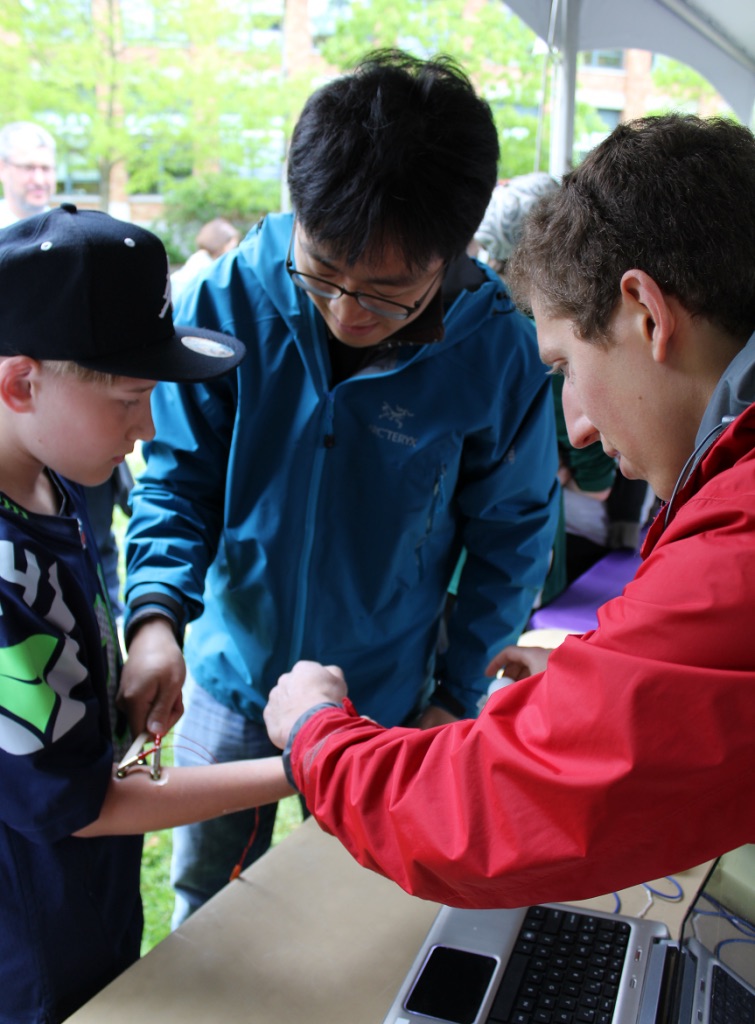
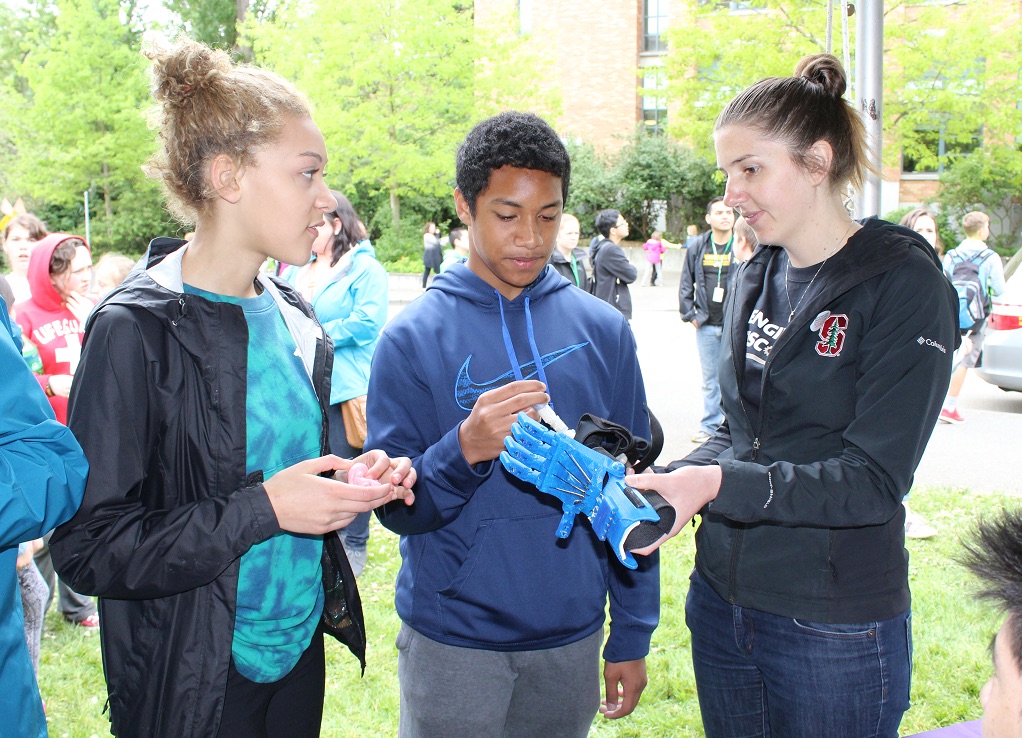
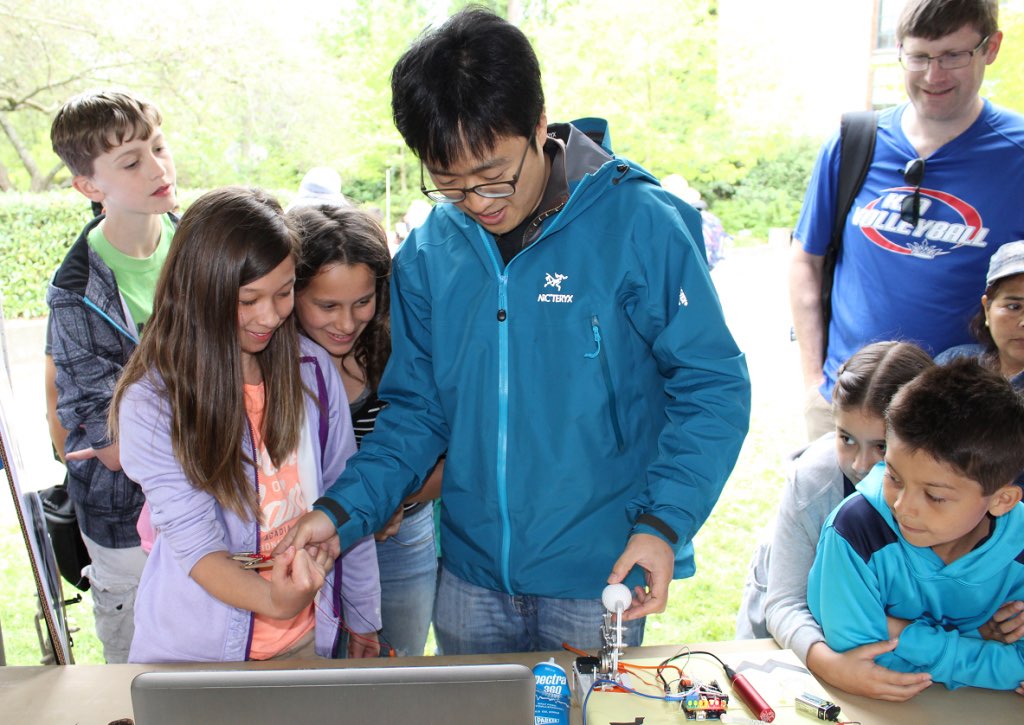
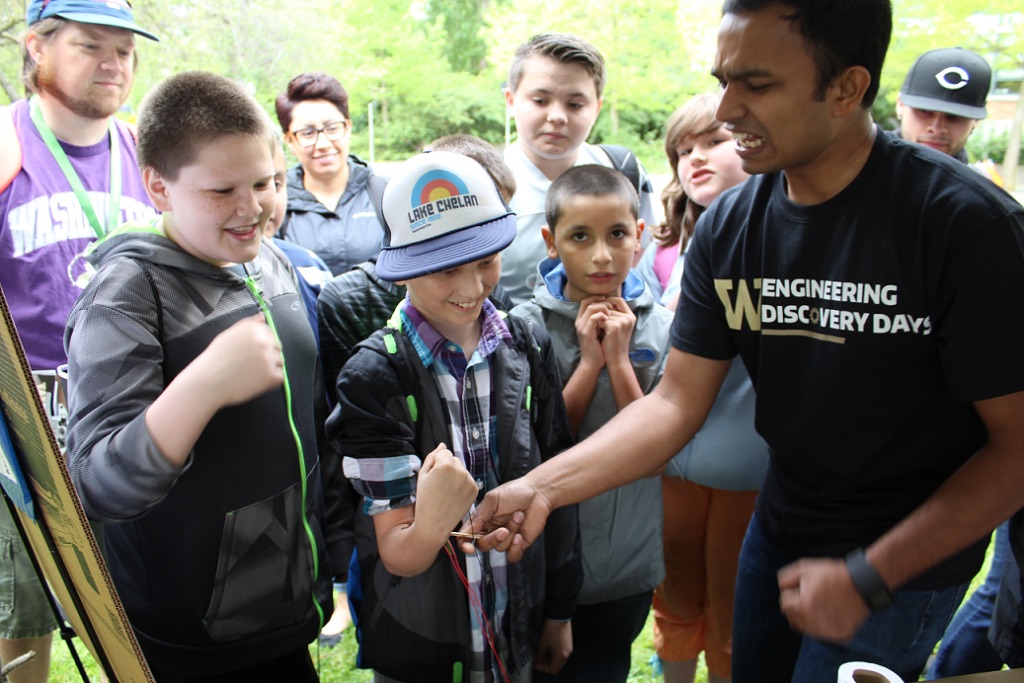
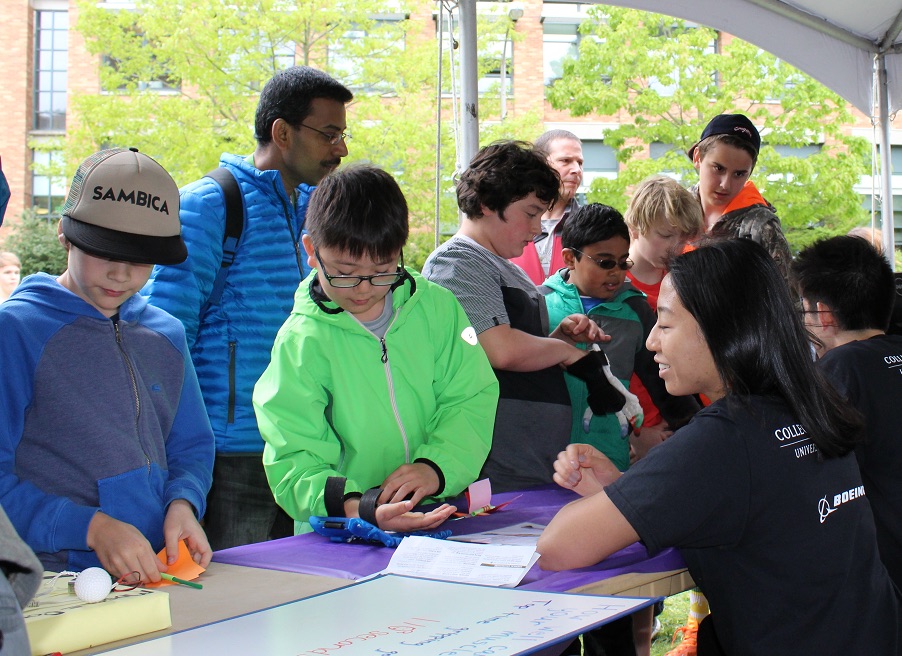
MotorControl
MH Schwartz, A Rozumalski, KM Steele (2016) “Dynamic motor control is associated with treatment outcomes for children with cerebral palsy.” Developmental Medicine & Child Neurology
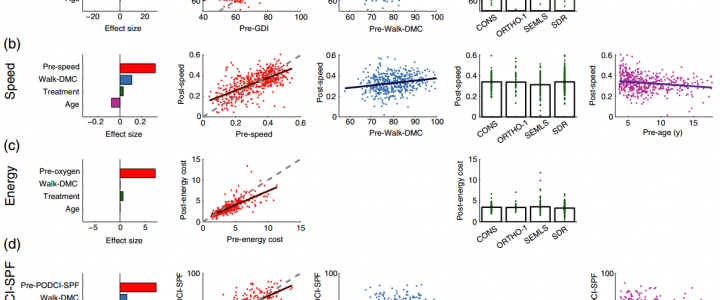
Journal article in Developmental Medicine & Child Neurology:
Kat Steele partnered with Michael Schwartz from Gillette Children’s Specialty Healthcare to investigate the impact of dynamic motor control on varying treatments in children with cerebral palsy.
Aim
To estimate the impact of dynamic motor control on treatment outcomes in children with cerebral palsy.
Method
We used multiple regression on a retrospective cohort of 473 ambulatory children with cerebral palsy who underwent conservative treatment, single-level orthopaedic surgery, single-event multi-level orthopaedic surgery, or selective dorsal rhizotomy. Outcomes included gait pattern, gait speed, energy cost of walking, and the Pediatric Outcomes Data Collection Instrument. Explanatory variables considered were pre-treatment levels of each outcome, treatment group, prior treatment, age, and dynamic motor control computed from surface electromyography using synergy analysis. Effect sizes were estimated from the adjusted response.
Results
Pre-treatment levels had effect sizes 2 to 13 times larger than the next largest variable. Individuals with milder pre-treatment involvement had smaller gains or actual declines. Dynamic motor control was significant in all domains except energy cost. The effect size of dynamic motor control was second only to pre-treatment level, and was substantially larger than the effect size of treatment group for outcomes where both were significant (gait pattern 2:1, gait speed 4:1). The effect of dynamic motor control was independent of treatment group.
Interpretation
Dynamic motor control is an important factor in treatment outcomes. Better dynamic motor control is associated with better outcomes, regardless of treatment. PDF
BR Shuman, M Goudriaan, L Bar-On, MH Schwartz, K Desloovere, KM Steele (2016) “Repeatability of muscle synergies within and between days for typically developing children and children with cerebral palsy.” Gait & Posture.
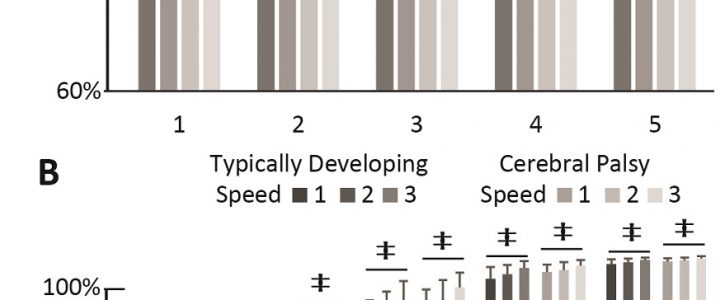
Journal article in Gait and Posture:
Filtering parameters impact the results from muscle synergy analyses.
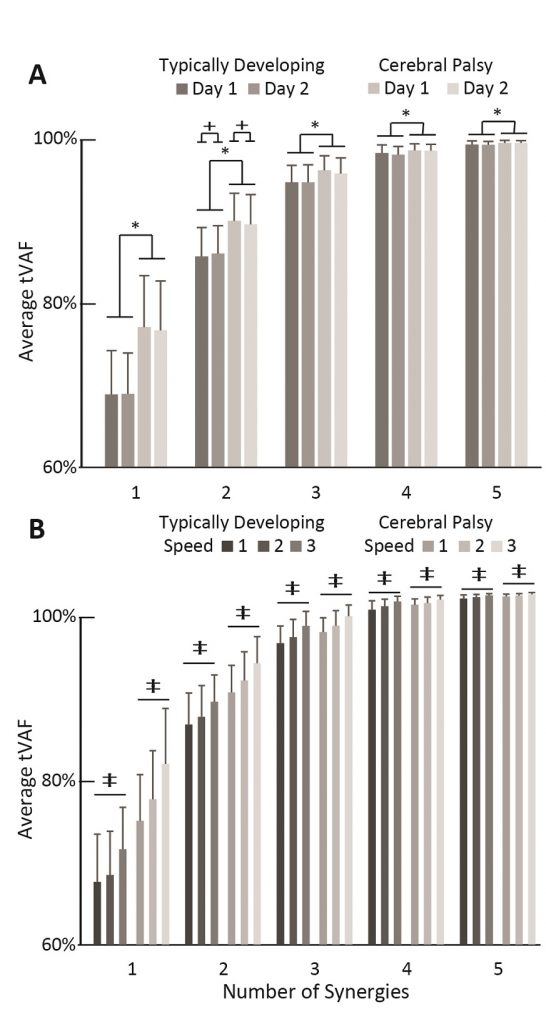 Abstract: Muscle synergies are typically calculated from electromyographic (EMG) signals using nonnegative matrix factorization. Synergies identify weighted groups of muscles that are commonly activated together during a task, such as walking. Synergy analysis has become an emerging tool to evaluate neuromuscular control; however, the repeatability of synergies between trials and days has not been evaluated. The goal of this study was to evaluate the repeatability of synergy complexity and structure in unimpaired individuals and individuals with cerebral palsy (CP). EMG data were collected from eight lower-limb muscles during gait for six typically developing (TD) children and five children with CP on two separate days, over three walking speeds. To evaluate synergy complexity, we calculated the total variance accounted for by one synergy (tVAF1). On a given day, the average range in tVAF1 between gait cycles was 18.2% for TD and 19.1% for CP. The average standard deviation in tVAF1 between gait cycles was 4.9% for TD and 5.0% for CP. Average tVAF1 calculated across gait cycles was not significantly different between days for TD or CP participants. Comparing synergy structure, the average (standard deviation) within day correlation coefficients of synergy weights for two or more synergies were 0.89 (0.15) for TD and 0.88 (0.15) for CP. Between days, the average correlation coefficient of synergy weights for two or more synergies was greater than 0.89 for TD and 0.74 for CP. These results demonstrate that synergy complexity and structure averaged over multiple gait cycles are repeatable between days in both TD and CP groups.
Abstract: Muscle synergies are typically calculated from electromyographic (EMG) signals using nonnegative matrix factorization. Synergies identify weighted groups of muscles that are commonly activated together during a task, such as walking. Synergy analysis has become an emerging tool to evaluate neuromuscular control; however, the repeatability of synergies between trials and days has not been evaluated. The goal of this study was to evaluate the repeatability of synergy complexity and structure in unimpaired individuals and individuals with cerebral palsy (CP). EMG data were collected from eight lower-limb muscles during gait for six typically developing (TD) children and five children with CP on two separate days, over three walking speeds. To evaluate synergy complexity, we calculated the total variance accounted for by one synergy (tVAF1). On a given day, the average range in tVAF1 between gait cycles was 18.2% for TD and 19.1% for CP. The average standard deviation in tVAF1 between gait cycles was 4.9% for TD and 5.0% for CP. Average tVAF1 calculated across gait cycles was not significantly different between days for TD or CP participants. Comparing synergy structure, the average (standard deviation) within day correlation coefficients of synergy weights for two or more synergies were 0.89 (0.15) for TD and 0.88 (0.15) for CP. Between days, the average correlation coefficient of synergy weights for two or more synergies was greater than 0.89 for TD and 0.74 for CP. These results demonstrate that synergy complexity and structure averaged over multiple gait cycles are repeatable between days in both TD and CP groups.
Webinar: Synergy-based Control in OpenSim
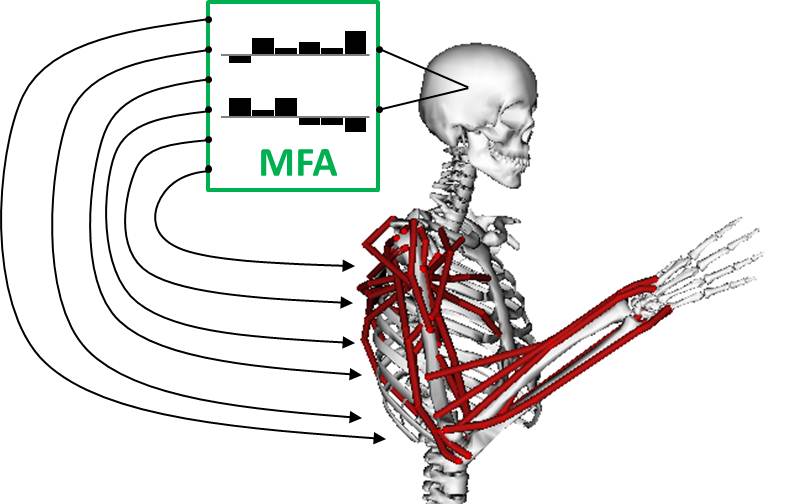 Join us January 27th for an OpenSim webinar lead by our director, Kat Steele.
Join us January 27th for an OpenSim webinar lead by our director, Kat Steele.
Details
Title: Synergy-based Control in OpenSim: Coupled Muscle Activity in Static Optimization
Speakers: Kat Steele, University of Washington
Time: Wednesday, January 27, 2016 at 10:00 a.m. Pacific Standard Time
Registration: To register for this event, click HERE. (webinar is free, but registration is required)
Abstract
How humans control movement remains an open question. One theory suggests that muscles may be activated in weighted groups, commonly referred to as muscle synergies, modes, or modules. A small number of synergies have been shown to describe
muscle activity in both animals and humans during tasks such as walking and reaching; however, whether these synergies reflect underlying neural control or other constraints remains unclear. An advantage of musculoskeletal simulation is that we can specify and test different control strategies.
In this webinar, Dr. Steele will discuss an OpenSim plug-in that lets users couple the activation of multiple muscles in weighted groups through static optimization. She will demonstrate applications of this plug-in for evaluating synergy-based control and testing the impacts of variable muscle weightings on tibiofemoral contact forces.
More information about this work can be found within the publication“Consequences of biomechanically constrained tasks in the design and interpretation of synergy analyses.”
SSM Lee, D Gaebler-Spira, LQ Zhang, WZ Rymer, KM Steele, (2016) “Use of shear wave ultrasound elastography to quantify muscle properties in cerebral palsy.” Clinical Biomechanics
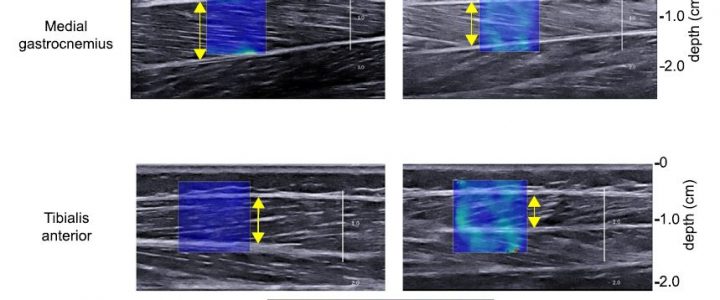
Journal article in Clinical Biomechanics:
Kat Steele partnered with Sabrina Lee from Northwestern University and the Rehabilitation Institute of Chicago to investigate shearwave ultrasound elastography as a new tool to quantify changes in muscle properties in cerebral palsy.
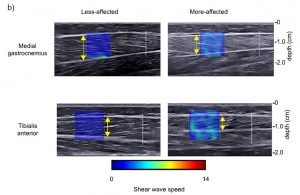 Abstract: Individuals with cerebral palsy tend to have altered muscle architecture and composition, but little is known about the muscle material properties, specifically stiffness. Shear wave ultrasound elastography allows shear wave speed, which is related to stiffness, to be measured in vivo in individual muscles. Our aim was to evaluate the material properties, specifically stiffness, as measured by shear wave speed of the medial gastrocnemius and tibialis anterior muscles in children with hemiplegic cerebral palsy across a range of ankle torques and positions, and fascicle strains. Shear wave speed was measured bilaterally in the medial gastrocnemius and tibialis anterior over a range of ankle positions and torques using shear wave ultrasound elastography in eight individuals with hemiplegic cerebral palsy. B-mode ultrasound was used to measure muscle thickness and fascicle strain. Shear waves traveled faster in the medial gastrocnemius and tibialis anterior of the more-affected limb by 14% (P = 0.024) and 20% (P = 0.03), respectively, when the ankle was at 90°. Shear wave speed in the medial gastrocnemius increased as the ankle moved from plantarflexion to dorsiflexion (less affected: r2 = 0.82, P < 0.001; more-affected: r2 = 0.69, P < 0.001) and as ankle torque increased (less affected: r2 = 0.56,P < 0.001; more-affected: r2 = 0.45, P < 0.001). In addition, shear wave speed was strongly correlated with fascicle strain (less affected: r2 = 0.63, P < 0.001; more-affected: r2 = 0.53, P < 0.001). The higher shear wave speed in the more-affected limb of individuals with cerebral palsy indicates greater muscle stiffness, and demonstrates the clinical potential of shear wave elastography as a non-invasive tool for investigating mechanisms of altered muscle properties and informing diagnosis and treatment.
Abstract: Individuals with cerebral palsy tend to have altered muscle architecture and composition, but little is known about the muscle material properties, specifically stiffness. Shear wave ultrasound elastography allows shear wave speed, which is related to stiffness, to be measured in vivo in individual muscles. Our aim was to evaluate the material properties, specifically stiffness, as measured by shear wave speed of the medial gastrocnemius and tibialis anterior muscles in children with hemiplegic cerebral palsy across a range of ankle torques and positions, and fascicle strains. Shear wave speed was measured bilaterally in the medial gastrocnemius and tibialis anterior over a range of ankle positions and torques using shear wave ultrasound elastography in eight individuals with hemiplegic cerebral palsy. B-mode ultrasound was used to measure muscle thickness and fascicle strain. Shear waves traveled faster in the medial gastrocnemius and tibialis anterior of the more-affected limb by 14% (P = 0.024) and 20% (P = 0.03), respectively, when the ankle was at 90°. Shear wave speed in the medial gastrocnemius increased as the ankle moved from plantarflexion to dorsiflexion (less affected: r2 = 0.82, P < 0.001; more-affected: r2 = 0.69, P < 0.001) and as ankle torque increased (less affected: r2 = 0.56,P < 0.001; more-affected: r2 = 0.45, P < 0.001). In addition, shear wave speed was strongly correlated with fascicle strain (less affected: r2 = 0.63, P < 0.001; more-affected: r2 = 0.53, P < 0.001). The higher shear wave speed in the more-affected limb of individuals with cerebral palsy indicates greater muscle stiffness, and demonstrates the clinical potential of shear wave elastography as a non-invasive tool for investigating mechanisms of altered muscle properties and informing diagnosis and treatment.
